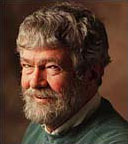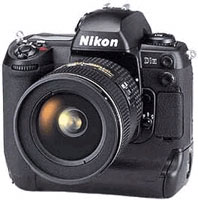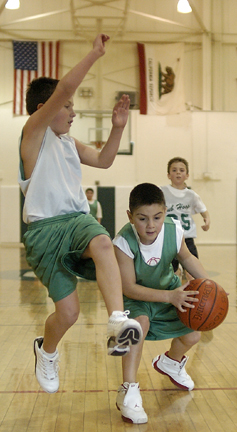 |
 | |
The Nikon D2H Digital Camera
March 2004
|
 |
|
Nikon's latest entry into the digital race, the D2H, is very fast. It's an instant turn on, in feel and handling as well as shooting readiness.
A 2.5-inch high resolution LCD screen makes easy work of checking images and reading menus in any light. The new Lithium-Ion battery is not only lighter but also lasts much, much longer, over 1000 images with a fair amount of screen checking per charge. The playback mode lets you look at an image and magnify it with the zoom tool up to 4X as soon as you shoot it, no waiting for image processing. The battery, which fully charges in about 90 minutes, has a very detailed menu display which shows not only percentage used but also the number of shots taken.
Richard LoPinto, Nikon's Vice President of SLR Marketing says that: "Digital technology is still growing and quickly improving." He points out that the Nikon F3 was on the market for 23 years and their first Digital SLR, the D1 was sold for 631 days!
He also says "the mega pixel battle is now more of a mega pixel scuffle because total image quality is more important than mega pixels alone. While photographers routinely associate image quality and especially image sharpness with mega pixel count alone, engineers understand that there are a multitude of additional factors that affect sharpness and total image quality."
I was lucky enough to use a prototype of the D2H for a few days in October, a few in November and finally a production model for the last month or so.
I was very impressed with the new LBCAST sensors ability to combine speed with image quality. You can preset up to four combinations of Custom instructions for specific venues and easily switch between them. As far as storage for all those eight frame bursts, CF cards of 2 GB and higher are supported.
I want to share with you other reviews posted on the web that get into the technical specifications much more deeply than I will. Two of my favorites are Rob Galbraith at www.robgalbraith.com and Thom Hogan's at www.bythom.com/d2h.htm.
Other fine sources of information are www.sportshooter.com where Robert Hanashiro's D2H: Good News or Bad News and Mike Terrill's take on the Nikon D2H offer more in depth comments on using the camera on assignment. Uwe Steinmueller uses a diary approach to describe his test efforts at: www.outbackphoto.com/reviews. He also has some European friends who chime in with their opinions on his site.
The new white balance system does a fine job in the auto mode and also allows manual setting of Kelvin color temperatures from 2,50K to 10,000K. In addition you can preset up to five white balance settings for the venues that you shoot regularly
When you get time to play with that NEF/RAW file you have many options to adjust exposure, white balance and tone control so you can fine-tune the image to your memory of the scene.
Unique to Capture 4 are Digital DEE, which is described as a "scene specific dodge and burn control" and Image Dust Off, which uses a reference image that you take when you begin the assignment to map dust on the sensor and then remove it. The enhanced batch processing allows correcting of a series from the same event after perfecting one image. It is a great time saver, especially in tricky lighting situations.
If I have any regrets from the time spent with the camera it is that I did not get to test the SB-800 flash. I saw it in action and know that it works and works well. Its auto FP function will synch up to 1/8000 of a second so you can use flash fill at wide apertures in bright light in automatic I-TTL mode. It also is much more accurate than previous units on digital cameras using a new pre-flash scheme that automatically balances the light output.
For multiple flash applications, the ability to use the flash on camera as a master controller to operate three other groups of flashes, of course other SB800's, is very exciting. You can fine-tune your exposure by dialing up or down the intensity from as many other SB800's as you can afford. Check that big LCD to see what you are creating and adjust some more. You can even turn off the flash on the camera and still control the other units. If you use a lot of multiple flashes on location you can only imagine how this would simplify things.
There is a lot of rumble about noise in the higher ASA's of the D2H. To me it does not seem to be worse than anything else out there and actually it is much better than most.
From all I have read and then experimented with, it would seem that underexposure in shadow areas is the biggest noise culprit as it is with any digital camera. In addition, sharpening of out of focus areas of an image can emphasize noise. If you have time to make sure that you only apply the unsharp mask to areas that are in focus you can really minimize the noisy/grainy look.
In conclusion, the Nikon D2H makes very nice pictures very rapidly. The image quality is excellent. The combination of color and acuity is better than previous models so if you expose well you can rival much higher MP cameras easily. Speed wise there is really no contest when you figure in how fast the camera is ready from the moment you turn it on till you fill the buffer, if you can.
PS: I did not get to play with the Wi-Fi wireless transmitter so I cannot offer any insight. It is lightweight, attaches directly to the camera through the D2H's USB 2.0 port and has great potential.
© Chick Harrity
|
|
|
Write a Letter to the Editor
Join our Mailing List
© The Digital Journalist
|
 This camera is as quick or quicker than an F5 in response time. With its 8 frames a second motor, a large buffer that will hold 40 exposures in JPEG or 24 in RAW and a much-improved auto focus system, this camera is ready for action when you are. The AF system now has 11 sensors with 9 of them being cross-type. That means they cover the majority of the image area and you can select which one or ones you want to be active at any time.
This camera is as quick or quicker than an F5 in response time. With its 8 frames a second motor, a large buffer that will hold 40 exposures in JPEG or 24 in RAW and a much-improved auto focus system, this camera is ready for action when you are. The AF system now has 11 sensors with 9 of them being cross-type. That means they cover the majority of the image area and you can select which one or ones you want to be active at any time. Realistically it is not a perfect camera for everyone because some feel a need for more than 4.1 mega-pixels and others want to make pictures at 1600 ASA that look like they were shot with Kodachrome 25 rather than Kodachrome 200 pushed a couple of stops. However for serious news and sports shooters it is hard to beat right now.
Realistically it is not a perfect camera for everyone because some feel a need for more than 4.1 mega-pixels and others want to make pictures at 1600 ASA that look like they were shot with Kodachrome 25 rather than Kodachrome 200 pushed a couple of stops. However for serious news and sports shooters it is hard to beat right now. I chose to shoot my tests in the NEF (Nikon Electronic Format or RAW) mode so that I could learn the new features of the Capture 4.0 software as I went along. As a result I know now that it takes a lot longer to process a NEF file in Capture than it does to run a JPEG through Photoshop. However the option of saving files in both formats simultaneously allows you quick output for transmission with the JPEG and the RAW file for archiving. I also saved images in the compressed NEF mode and saw no difference in image quality. Color Mode was set at Mode II (Adobe RGB) for all the tests. Setting the tone control to normal rather than auto seemed to produce the best results most of the time.
I chose to shoot my tests in the NEF (Nikon Electronic Format or RAW) mode so that I could learn the new features of the Capture 4.0 software as I went along. As a result I know now that it takes a lot longer to process a NEF file in Capture than it does to run a JPEG through Photoshop. However the option of saving files in both formats simultaneously allows you quick output for transmission with the JPEG and the RAW file for archiving. I also saved images in the compressed NEF mode and saw no difference in image quality. Color Mode was set at Mode II (Adobe RGB) for all the tests. Setting the tone control to normal rather than auto seemed to produce the best results most of the time.